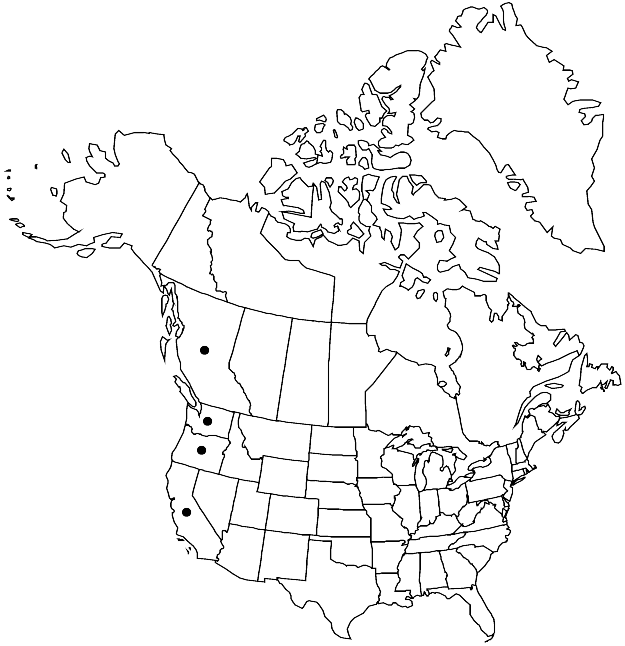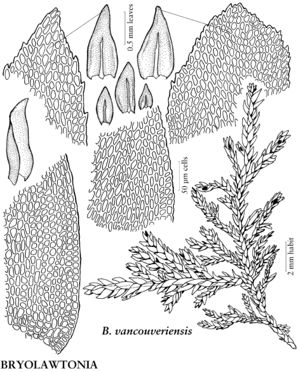Bryolawtonia vancouveriensis
Bryologist 93: 329. 1990.
Secondary stems decumbent, sometimes appearing prostrate, pinnate usually in one plane, branches similar to each other, with inconspicuous prostrate and microphyllous stolon giving rise to series of plumose decumbent to ascending axes to 3 cm; central strand absent; pseudoparaphyllia short, broad; axillary hairs 2- or 3-celled, to 100 µm, basal cell 1, brown, not offset from leaf insertion; rhizoids on stem below abaxial costal insertion, red-brown. Secondary stem and branch leaves complanate, broadest near base, sometimes contracted mid leaf and ligulate distally, to 1 mm, 2–3.5:1; lateral leaves asymmetric with postical margins broadly incurved at base; base somewhat cordate; margins plane, some recurvature at and sometimes before mid leaf, serrulate distally, occasionally throughout; costa 1/2–3/4 leaf length, often 2-fid distally; alar cells quadrate to transversely elongate, walls thick, region to 10 cells wide; medial laminal cells 6–9 µm, 2–5:1, smooth, lumen/wall ratio to 1:1, walls thick, lumina rounded; apical cells rhomboidal, nearly isodiametric. Perigonia on main axis or terminal on short lateral branches. Perichaetia on main axis, to 3 mm, strongly convolute around seta. Seta erect, short-exserted. Capsule inclined, exserted, brown, curved, not distorted or sulcate when dry, somewhat strangulate, urn to 1.8 mm, 2–3:1; exothecial cells 12–18 µm, 1–3:1, walls thick; stomata restricted to neck; operculum short-rostrate; exostome teeth 16, red-brown; endostome well developed, shorter than exostome, segments narrow, nearly as long as exostome, open on keel, cilia 2, well developed, appendiculate. Spores low-papillose.
Phenology: Capsules mature spring.
Habitat: Broad-leaved trees, rock
Elevation: moderate elevations (200-1000 m)
Distribution

B.C., Calif., Oreg., Wash.
Discussion
Plants of Bryolawtonia vancouveriensis are mostly epiphytic on broad-leaved trees but also on moist rock. In northern parts of its range, deciduous angiosperms such as Alnus are the major phorophytes for B. vancouveriensis. To the south, the plants are especially abundant on the burls of Umbellularia. A form of Bryolawtonia vancouveriensis has been called Bestia occidentalis (Kindberg) Grout. Bestia occidentalis is very different in leaf arrangement (erect and pressed to stem); in leaf shape (broadest at the base and approaching acute at the apex); and branching pattern (clustered near the top of the decumbent axis). Nearly all the plants of this morphology are found in coastal British Columbia and Washington. There are, however, too many intergradations in this form for it to be recognized.
Selected References
None.
